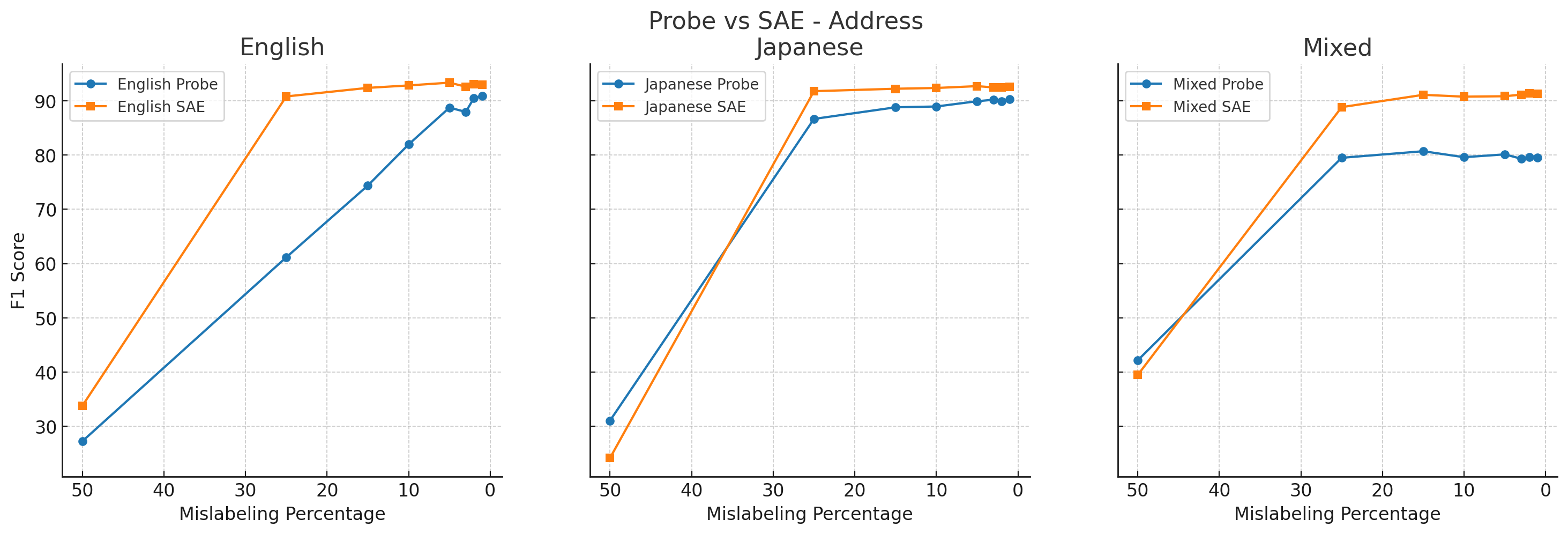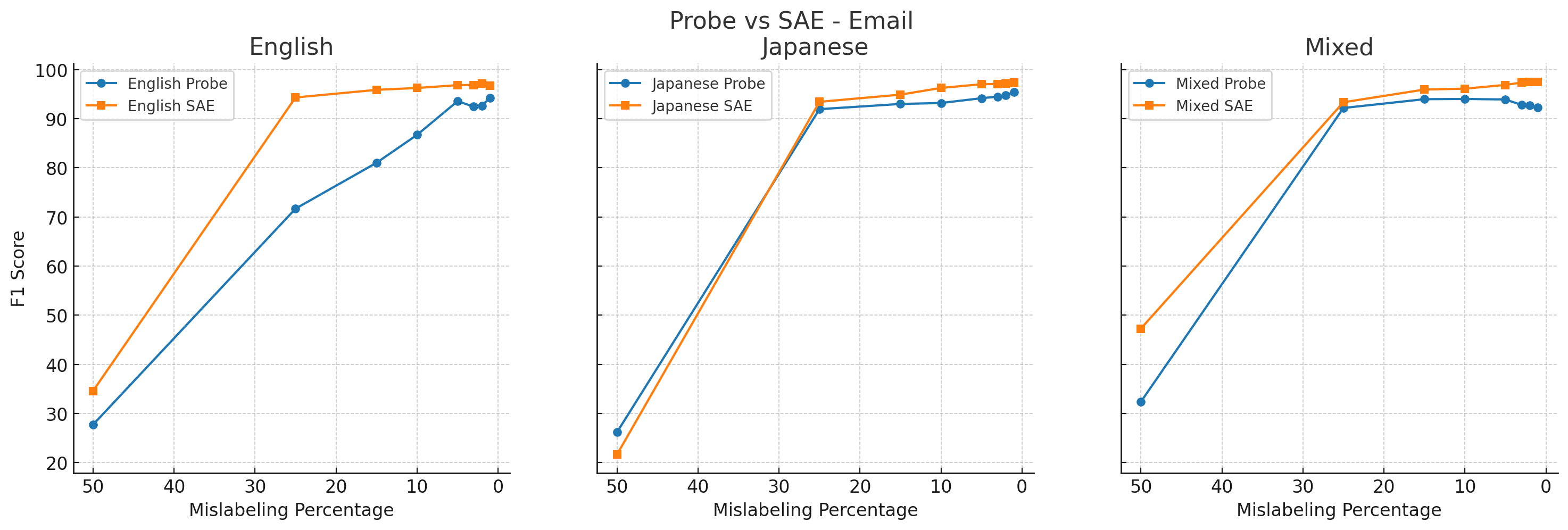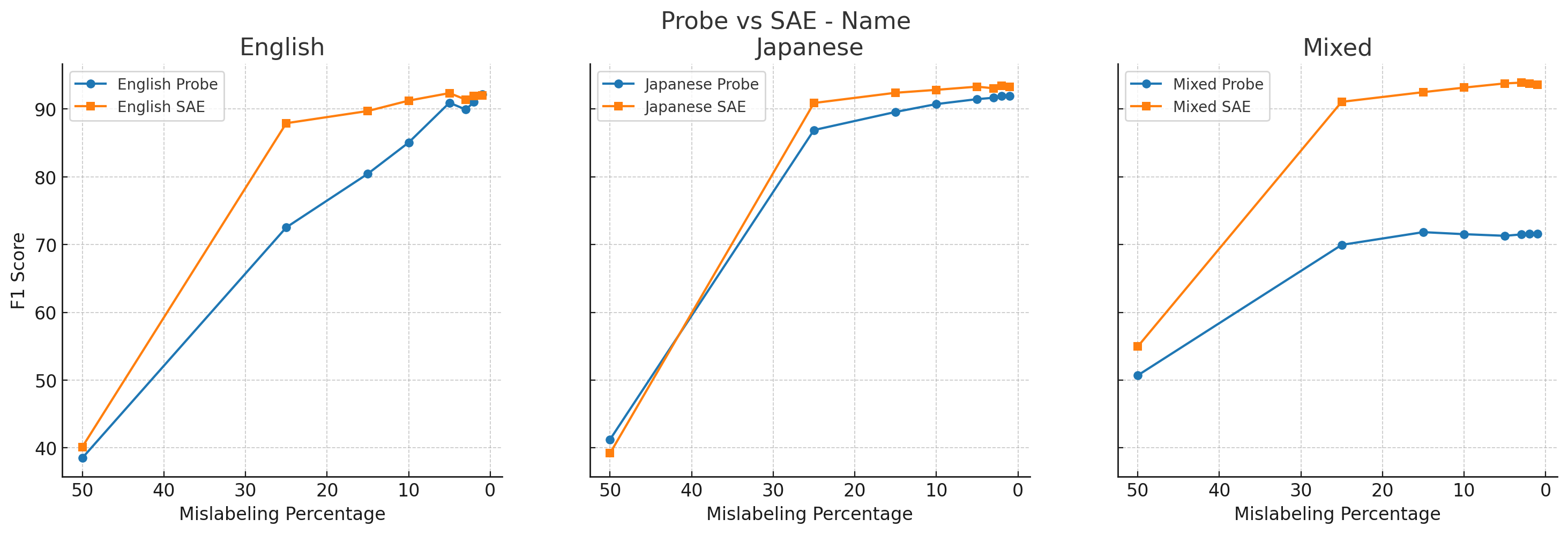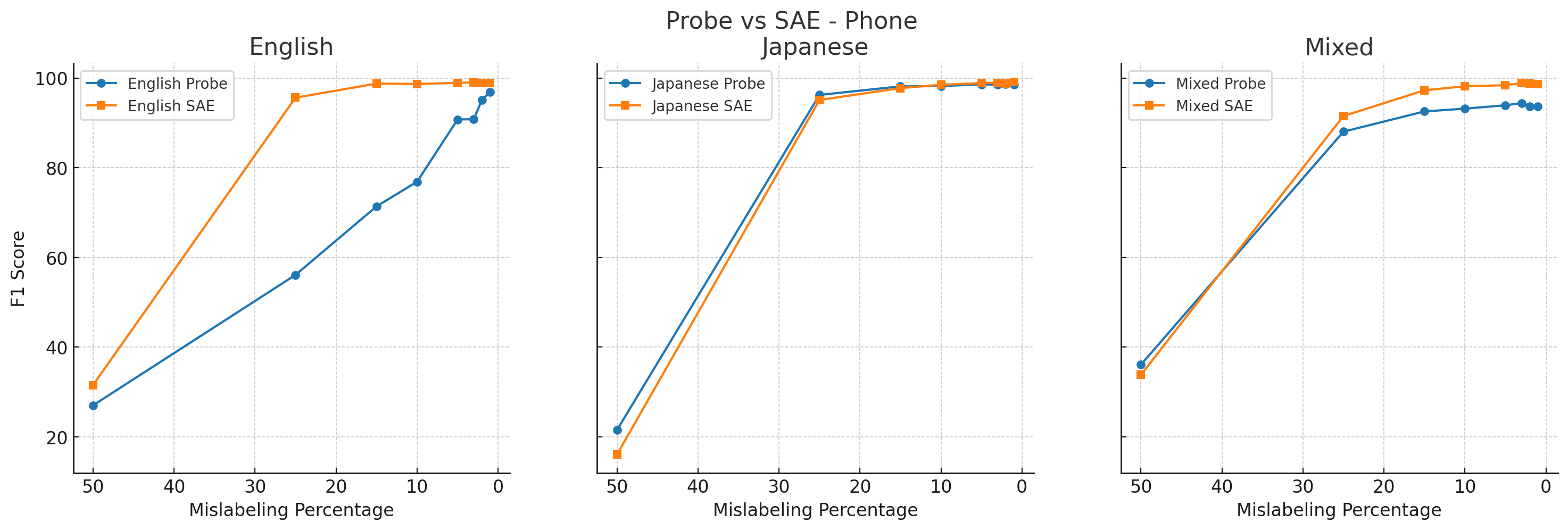
Deploying Interpretability to Production with Rakuten: SAE Probes for PII Detection
We detail one of the first uses of sparse autoencoders (SAEs) with a production AI model - using SAE probes to detect personally identifiable information for Rakuten AI agents - and find they generalize from synthetic to real data much better than other probes. We also show that probes are far more efficient and inexpensive on the task than LLM-as-judge baselines, while exhibiting comparable performance.
Authors
Published
October 28, 2025
† Goodfire
‡ Rakuten
Correspondence to michael.byun@goodfire.ai
Contents
Introduction
We partnered with Rakuten to evaluate the utility of interpretability-based methods in a production‑critical enterprise setting: the detection of personally identifiable information (PII) within multilingual (English and Japanese) user messages to their agent platform.
Founded in Tokyo in 1997, Rakuten is a global technology leader in services that empower individuals, communities, businesses and society, serving over 44 million monthly active users in Japan and a total of two billion customers worldwide.
Our goal was to detect personally identifiable information (PII) in user-generated messages to Rakuten's AI agent so it can be filtered out before the input data is processed further. Implicit in this goal were a few design considerations: the methods needed to be lightweight, since they would be used on all interactions with the agent platform, and required very high recall - avoiding false negatives was paramount. Additionally, the methods needed to be trained on synthetic data (to avoid training on real users' PII), but perform on real production data.
At a high level, our approach was to try a portfolio of interpretability-based methods - including standard probes, attention probes, and sparse autoencoder (SAE) probes on a lightweight sidecar model - and compare their performance across the distribution shift from synthetic training data to real production data. Intuitively, we used the “cognition” of the model itself as the source of information about whether each token is PII, rather than the raw inputs.
Sparse autoencoders (SAEs) offer an unsupervised way of decomposing large language model activations into sparse feature sets corresponding to crisp semantic concepts. However, the practical value of using SAE features for supervised downstream tasks remains contested—especially when compared with other interpretability approaches, such as linear probes applied directly to hidden states.* Recent evaluations have primarily tested SAEs on well-defined classification tasks with high-quality labeled data and minimal distribution shift, potentially underestimating their value compared to baselines in real-world scenarios.
* cf. “Are Sparse Autoencoders Useful? A Case Study in Sparse Probing,” “Negative Results for Sparse Autoencoders On Downstream Tasks and Deprioritising SAE Research,” and “Detecting Strategic Deception Using Linear Probes”
We found that SAE probes outperformed other approaches when generalizing from synthetic to real production data - a critical requirement for many real-world monitoring approaches. SAE probes also outperformed other methods under other common data limitations, such as in non-English settings and under label noise.
We also show that probes offer 10–500x cost savings compared to common LLM-as-judge setups with comparable accuracy on the PII detection task, and that probing a sidecar model yields dramatically better performance (96% vs. 51%) than using the same model as a black-box judge.
As a result, Rakuten deployed the SAE probes - the first known enterprise application of SAEs for language model guardrails.
Approach
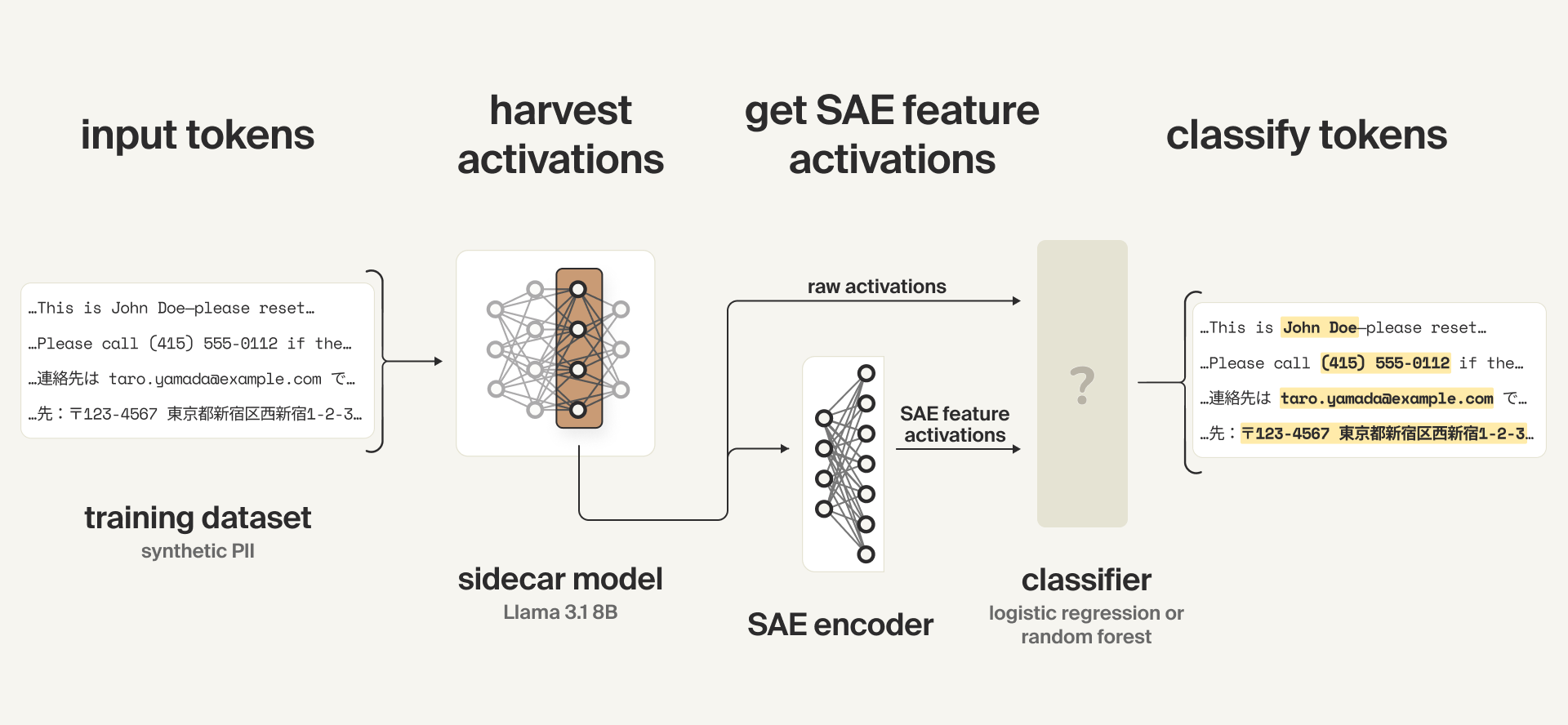
Our high-level approach was to:
- Train sparse autoencoders (SAEs) on the sidecar model
- Train both activation probes and SAE probes using a synthetic PII dataset
- Test the probes and select the most performant ones for deployment
Training the SAEs
Sparse autoencoders (SAEs) are among the most well-developed interpretability techniques. They capture a model's activations at a given layer and disentangle them into isolated, semantically coherent features. They do so by learning an encoding into a space which is much higher-dimensional than the model's hidden space, but in which the activations are much sparser (i.e., only a few features are active on any given input).
We trained an SAE on a middle layer of Llama 3.1 8B on a mixed-language dataset to learn a wide distribution of useful features, including those related to PII. More details on SAE training can be found in Appendix A.
The SAEs are frozen during probe training. Since we only care about the SAE's feature activations, we ignore the SAE decoder in our setup below.
Training the probes
We train both activation probes and SAE probes. Activation probes (sometimes just called probes) are small models trained on the activations from a hidden layer of a (frozen) larger model. SAE probes are similar, but with an extra step: their inputs are SAE feature activations - i.e. the same hidden layer activations which have been passed through an SAE encoder - which are sparser, more semantically interpretable representations.
In our case, all probes are classifiers which predict whether each token is one of various classes of PII.
Due to the sensitive nature of real PII, the training dataset was entirely synthetic. This means that our methods' performance would need to transfer from a synthetic training dataset to real production data, a substantial distribution shift (and an unpredictable one, given we had no access to Rakuten's production data). This limitation – of being unable to train on real user data, yet needing to perform well when deployed on it – is a common challenge for companies deploying models.
The activations are generated by a sidecar model, a smaller and faster model that runs in parallel with the primary model producing user-facing responses. In our configuration, we employ Llama 3.1 8B as the sidecar.
Our probe training setup involves:
- Passing training examples to the sidecar model
- Harvesting activations from an intermediate layer of the model
- For the SAE probes, passing those raw model activations to the SAE encoder to get SAE feature activations
- Using either the raw activations (for the activation probes) or the SAE feature activations (for the SAE probes) as inputs to a classifier which predicts token-level PII content. We tested a few different types of classifiers.
Formal setup
Formally: for each token $t$ in an input sequence (training example) $x$, with a frozen sidecar model $f_{\theta}$, a frozen SAE encoder consisting of a matrix $W_{\mathrm{enc}}$ and a BatchTopK activation function, and a generic classifier head $\mathrm{clf}$:
We harvest the model activations from the residual stream at the end of an intermediate layer $L$:
$$h = f_{\theta}^{(L)}(x,t)$$
The activation probe prediction is then
$$p_{\mathrm{act}} = \mathrm{clf}_{\mathrm{act}}(h),$$
and the SAE feature activations $z$ and SAE probe prediction $p_{\mathrm{SAE}}$ are
$$z = \mathrm{BatchTopK}\big(W_{\text{enc}}h\big)$$
$$p_{\mathrm{SAE}} = \mathrm{clf}_\mathrm{SAE}(z),$$
where $h \in \mathbb{R}^{\mathtt{hidden\_dim}}$, $z \in \mathbb{R}^{\mathtt{sae\_dim}}$, and $p \in \mathtt{\{personal\_name, address, phone, email, none\}}$.
Note: we use a variant of BatchTopK SAEs, which typically use a JumpReLU activation function at inference time; we instead use a sequence-wise TopK activation function at inference time.
Collecting activations
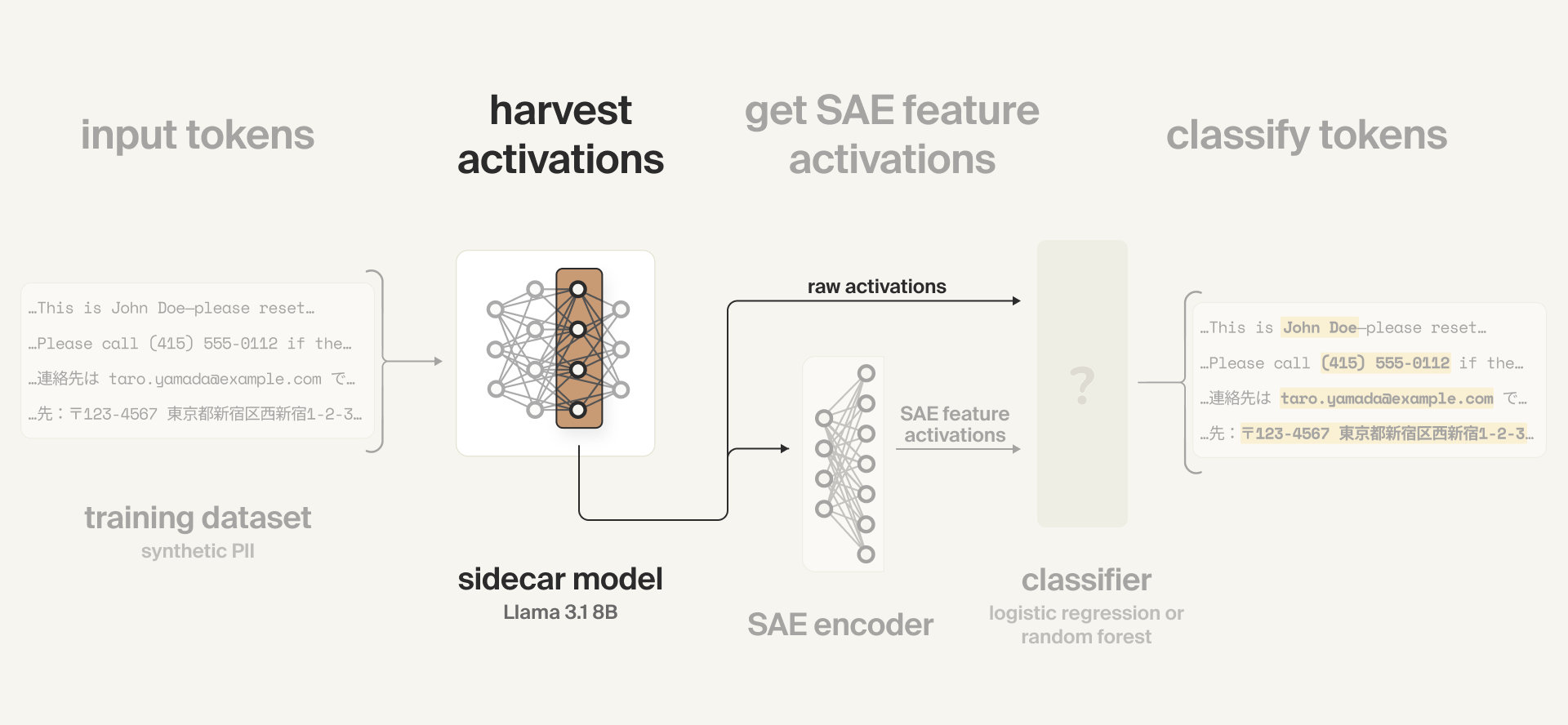
We split the training examples into chunks of 128 tokens max. We run a forward pass of the sidecar model on each chunk, and collect the model activations at an intermediate layer over every token position in the chunk.
These activations are then used directly, as inputs to the activation probe (classifier), and are also used as inputs for the SAE.
Note: training the SAE also requires harvesting activations, but that is a separate process. When training the SAE probes, the SAE has already been trained (and is thus frozen).
Collecting SAE features
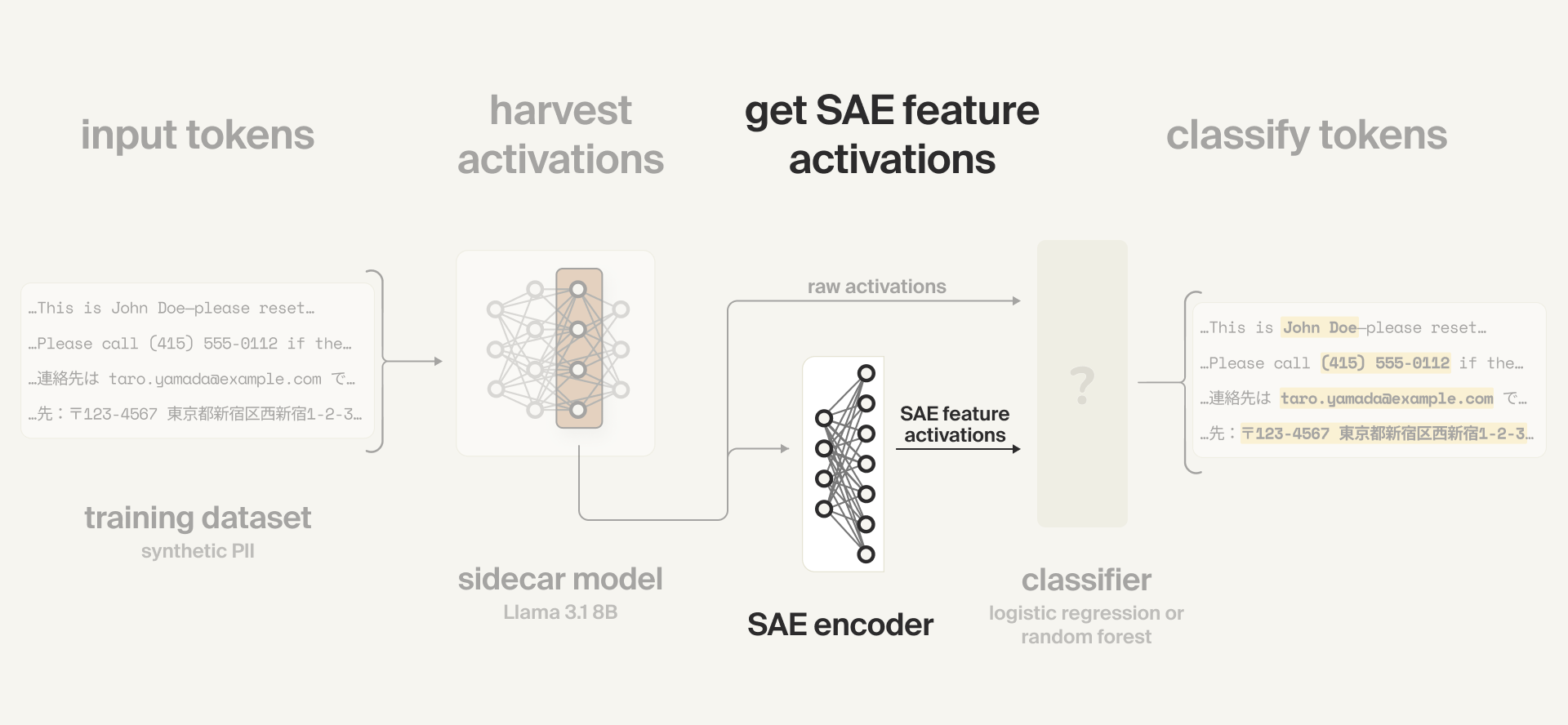
We then pass the raw model activations to our SAE encoder and collect the SAE feature activations (i.e., the activations of the disentangled concepts the model is using) to use as the inputs to the SAE probe (classifier).
Training the classifier heads
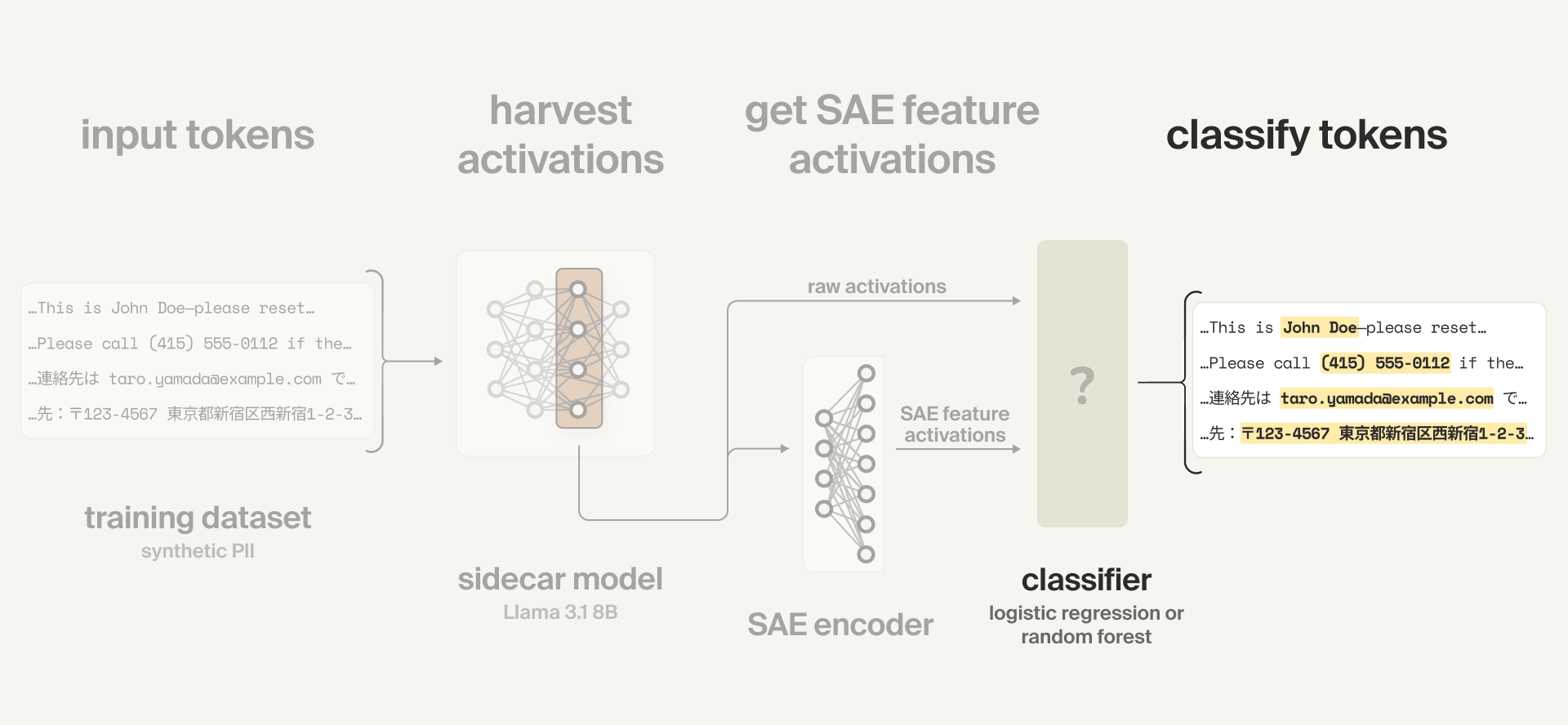
The final part of the probing setup - the probe itself - is a classifier which predicts whether each token is PII or not.
We experimented with logistic regressions, random forests, and XGBoost, and used random forest for our SAE probe and XGBoost for our activation probe (which were best-performing for their respective methods). We also report results for an activation probe using a random forest classification head for comparability with the SAE probe.
Attention probes
We also include two attention probes - a recent method which improves on naive probe architectures - as baselines. One attention probe takes the raw model activations as input, and the other takes SAE feature activations as input.
See Appendix B for more details on our attention probe setup.
Results
We compared the performance of three methods on the PII detection task:
- Our SAE probes
- Our activation probes
- A baseline, consisting of a DeBERTa model with a linear classification head which had been fine-tuned on the task.
Generalizing from synthetic to real data
Given that all three methods were trained using synthetic data (due to the sensitive nature of data containing real PII), we were particularly interested in how well the methods generalized from synthetic data to real production data. We thus evaluated over three different test distributions:
- Synthetic data (on-distribution), which are from the same distribution as the training data. These were LLM-generated.
- Synthetic data (semi-off-distribution), consisting of a mix of synthetic examples from the same distribution as the training data as well as synthetic examples created to better match the formatting and class imbalance of the production data distribution.
- Real data (off-distribution), which are real production data from Rakuten. These data represent a substantial distributional shift from the synthetic training data; they are more diverse in format and length, with a different distribution of PII classes.
The results below were evaluated using multilingual datasets (combination of English and Japanese examples). We focus on recall given the importance of avoiding false negatives in PII detection; see Appendix D.2 for F1 score plots. See Appendix C for definitions of the exact vs. partial match metrics.
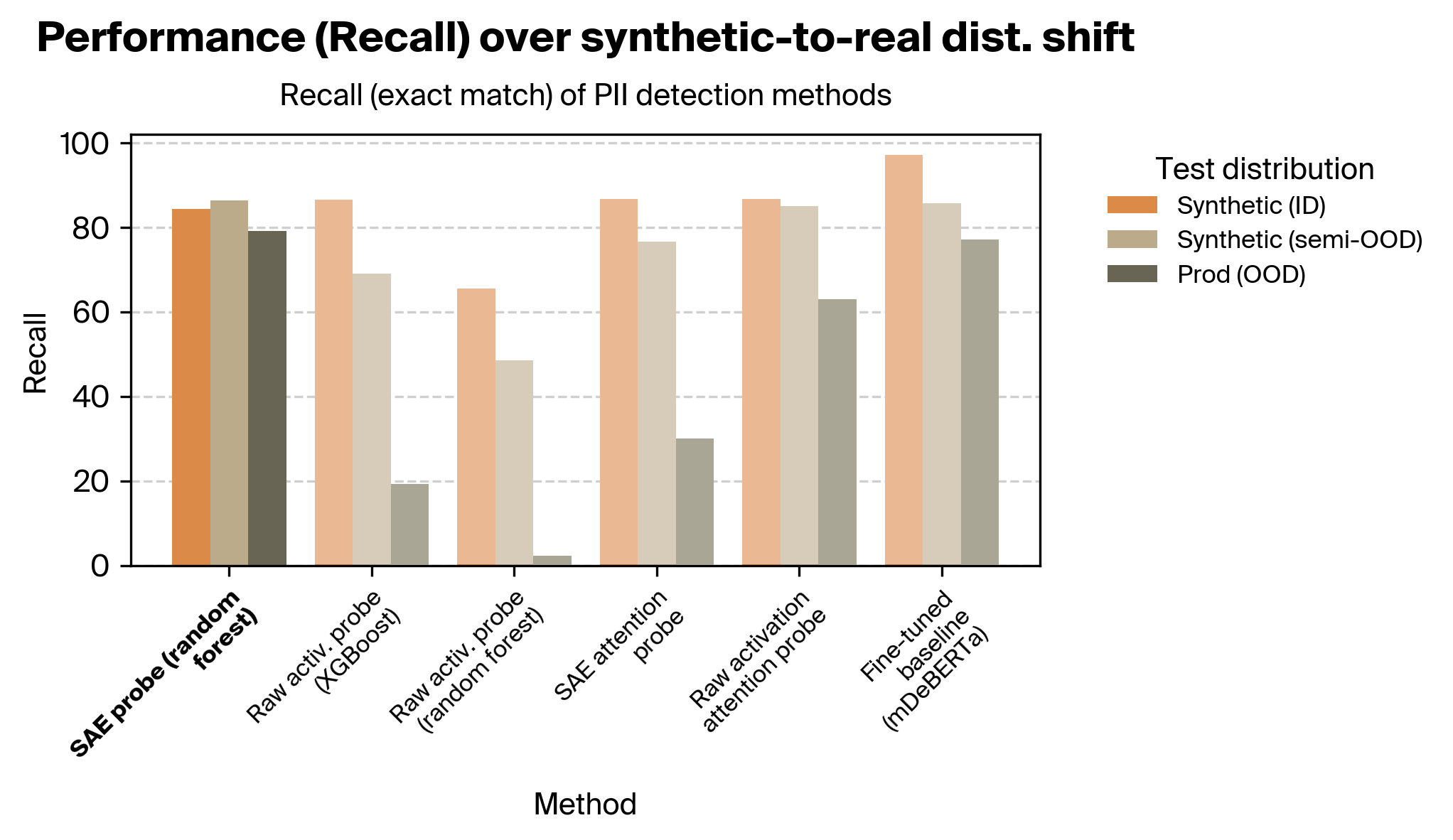
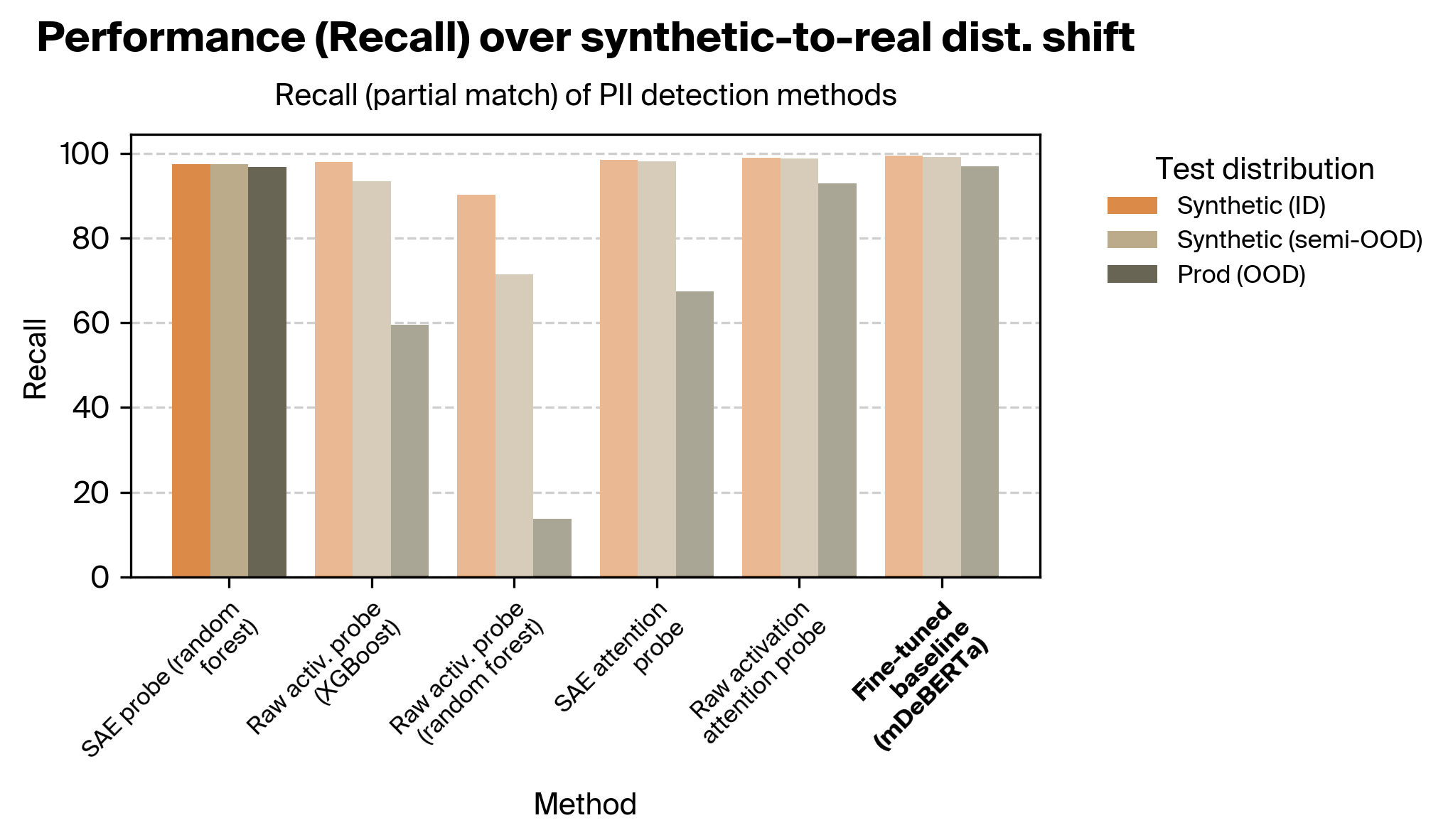
We found that our SAE probes outperformed our activation probes and all attention probes. In particular, our SAE probes were considerably more robust across the distribution shift from synthetic to real data.
The difference in robustness is particularly striking between the SAE probes and raw activation probes. The attention probes fare better, but even after performing extensive sweeps across hyperparameters and trying several architectural variants, they nonetheless exhibit poorer OOD performance. We speculate that this is because of how different this task is than prior work; see the discussion section for more.
The SAE probes also matched the fine-tuned baseline on the exact match metric, but underperformed it on the partial match metric.
Cost and performance compared to LLM-as-a-judge baselines
Using a black-box LLM-as-a-judge approach, in which an off-the-shelf LLM is prompted to perform the task in natural language and give the results in its outputs, is common practice in industry for classifying language data at scale. However, getting adequate LLM-as-a-judge performance generally requires using large frontier models, where inference is relatively expensive and high-latency compared to smaller models like Llama 8B.
We compared the performance (orange) and cost (gray) of our best probing approach to several models commonly used for LLM-as-a-judge pipelines. We found that our probe was between 10x and 500x cheaper than LLM-as-a-judge setups with comparable performance (GPT-5 Mini and Claude Opus 4.1, respectively).
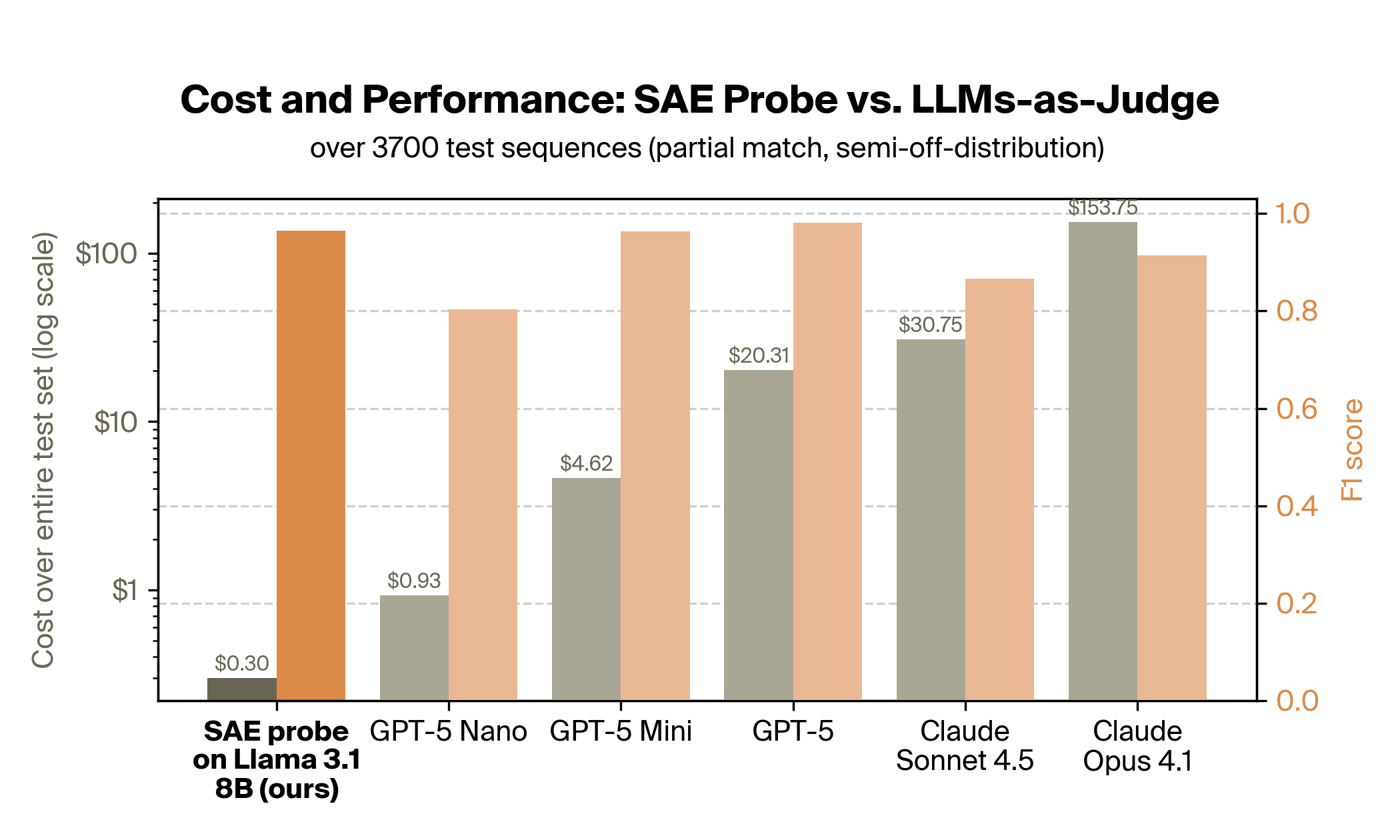
This cost saving applies to both activation probes and SAE probes, since both use a lightweight model; we show only the SAE probe as it is our best performing probe.
Notably, our method of probing the lightweight model (Llama 3.1 8B) achieves much higher performance than using its black-box outputs in an LLM-as-a-judge setup:
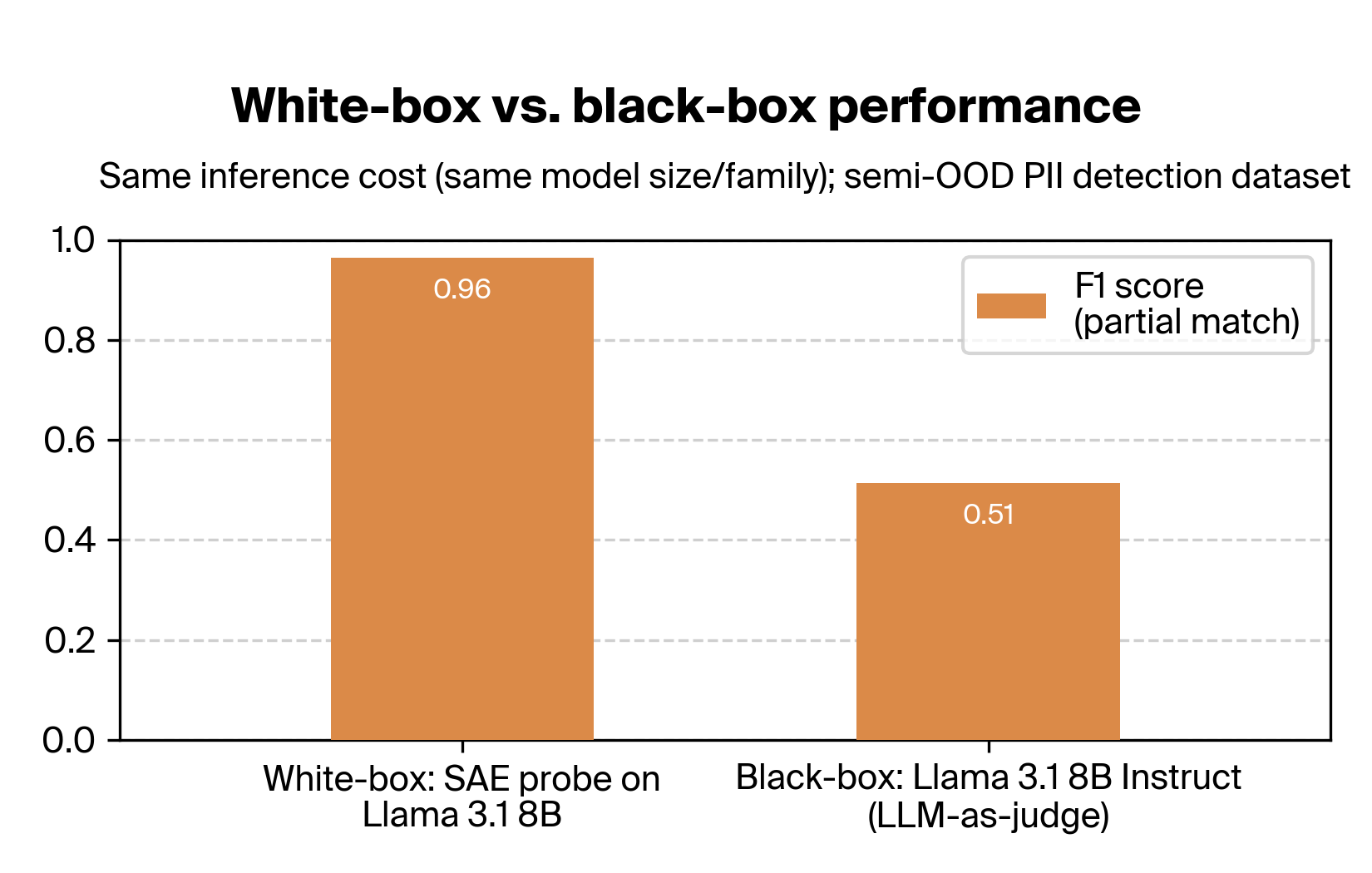
White-box performance is about double the black-box performance! Our SAE probe brings the F1 score up from 51% to 96% while using the exact same model at the same cost (in fact cheaper, since we don't need output tokens). This shows how model internals can contain substantial amounts of information that is difficult to elicit via prompting alone (though fine-tuning can be successful for this task).
Further results
We also found that our SAE probes outperformed our activation probes in other limited data environments, such as in non-English settings or when using training data where a fraction of examples has corrupted labels. More details on these experiments can be found in Appendix D.
Our initial investigations have also found that the features used by the SAE probe are very interpretable, but we do not report those results here. Future work will examine probe attribution and interpretability for validation and debugging.
Discussion
Prior work comparing SAE and activation probes
We were surprised to find that the SAE probes outperformed the activation probes at all. Prior work suggests that probing with SAE features does not usually outperform probing with raw activations (Kantamneni et al., 2025) and in particular does not generalize as well out of distribution (Smith et al., 2025, Goldowsky-Dill et al., 2025). However, Karvonen et al., 2024 provide an example in which SAEs do outperform activation-probe baselines (in a data-limited setting).
In contrast, SAE probes exceeded activation probes in nearly all of our experiments (the primary exception being English-only data).
We have a few hypotheses for why our results differ from most prior work:
- The synthetic-to-real distribution shift we study might be different (and in particular, larger) than the distribution shifts studied in prior work.
- Our SAE used a smaller expansion factor (8) than previous work (mostly 32). While there is no broadly agreed-upon heuristic for choosing an expansion factor, we expect that larger expansion factors lead to more feature splitting and poorer OOD generalization when working with small probe training datasets.
- Our task involved position-aware token-level classification, while Kantamneni et al. and Smith et al. examine whole-prompt classification tasks using max-pooled SAEs.
- Our task includes substantial data in Japanese - an unsupported/low-resource language for Llama 3.1 8B - whereas prior works consider English-only tasks. See Appendix D.3 for a plot of performance by language.
See Smith et al. for additional discussion of when SAEs may work better or worse for downstream tasks.
We also ran further experiments to better understand why our results differ from Kantamneni and Engels et al., including measuring activation vs. SAE probe performance as we vary label corruption, dataset size, and distributional shift. Details on these experiments can be found in Appendix D.
Further exploring the reasons for these results will be the subject of future research.
Why use a (SAE) probe over a fine-tuned sidecar model?
While SAE probes outperformed other probes on this task, they were matched (exact match) or exceeded (partial match) by the fine-tuned baseline, which uses a considerably smaller model than the probes. Why, then, would one use (SAE) probes?
For some contexts, you shouldn't! Fine-tuning is a powerful technique that can power many applications (as can prompting, though it tends not to work as well on lightweight models, as noted in the cost comparisons plot).
The advantage of probes is that they are lightweight, adaptable, and require minimal data to train. If you want to expand what a fine-tuned guardrail model is looking for, you need to either train it further while ensuring you don't degrade performance on existing tasks, or train another model and run multiple guardrail models at inference time. If you're already probing a sidecar model, you can add many more probes with less training and negligible marginal inference cost, while retaining the exact performance of your existing probes.
SAE probes in particular offer interpretable features, which can help validate that your probes are picking up on meaningful signals rather than spurious correlations.
Whereas fine-tuning gives you exactly the right tool for a job, SAE probes give you a toolkit of generally useful tools that you can train once and then use across many tasks.
Conclusion
Our experiments examined data limitations faced by many enterprises, specifically the need to train on synthetic data while maintaining performance on real data - as well as challenges posed by multilingual inputs and noisy labels.
These results show that SAEs (and other unsupervised interpretability techniques) can outperform naive activation probes for real-world guardrails. Unlike traditional supervised approaches that require extensive labeled datasets for each specific safety rule or policy domain, SAEs can automatically discover interpretable features from unlabeled text. This unsupervised discovery process is especially valuable in enterprise settings where companies may have dozens of nuanced compliance requirements but lack the resources to generate comprehensive training data for each rule category.
Our cost and latency comparisons also support the utility of probing methods when a deployment is prioritizing latency and inference costs, as is generally the case for guardrails.
As a result, Rakuten deployed SAE probes to detect PII for Rakuten AI agents - the first known enterprise application of SAEs for language model guardrails.
References
- BatchTopK Sparse Autoencoders [link]
Bart Bussmann, Patrick Leask, and Neel Nanda, 2024. arXiv:2412.06410. - Detecting Strategic Deception Using Linear Probes [link]
Nicholas Goldowsky-Dill, Bilal Chughtai, Stefan Heimersheim, and Marius Hobbhahn, 2025. arXiv:2502.03407. - DeBERTaV3: Improving DeBERTa Using ELECTRA-Style Pre-Training with Gradient-Disentangled Embedding Sharing [link]
Pengcheng He, Jianfeng Gao, and Weizhu Chen, 2021. arXiv:2111.09543. - DeBERTa: Decoding-Enhanced BERT with Disentangled Attention [link]
Pengcheng He, Xiaodong Liu, Jianfeng Gao, and Weizhu Chen, 2021. ICLR 2021 poster. - Are Sparse Autoencoders Useful? A Case Study in Sparse Probing [link]
Subhash Kantamneni, Joshua Engels, Senthooran Rajamanoharan, Max Tegmark, and Neel Nanda, 2025. arXiv:2502.16681. - Sieve: SAEs Beat Baselines on a Real-World Task (A Code Generation Case Study) [link]
Adam Karvonen, Dhruv Pai, Mason Wang, and Ben Keigwin, 2024. Tilde Research Blog, December 15, 2024. - Meta Llama 3.1 [link]
Meta AI, 2024. Meta AI Blog, July 23, 2024. - Attention Probes [link]
Stepan Shabalin and Nora Belrose, 2025. EleutherAI Blog. - Negative Results for SAEs On Downstream Tasks and Deprioritising SAE Research (GDM Mech Interp Team Progress Update #2) [link]
Lewis Smith, Senthooran Rajamanoharan, Arthur Conmy, Callum McDougall, Tom Lieberum, János Kramár, Rohin Shah, and Neel Nanda, 2025. AI Alignment Forum, March 26, 2025.
Citation
Nguyen, et al., “Deploying Interpretability to Production with Rakuten: SAE Probes for PII Detection”, Goodfire Research, 2025.
@article{nguyen2025deploying,
author = {Nguyen, Nam and Deng, Myra and Gala, Dhruvil and Naruse, Kenta and Virgo, Felix Giovanni and Byun, Michael and Hazra, Dron and Gorton, Liv and Balsam, Daniel and McGrath, Thomas and Takei, Mio and Kaji, Yusuke},
title = {Deploying Interpretability to Production with Rakuten: SAE Probes for PII Detection},
journal = {Goodfire},
year = {2025},
note = {https://www.goodfire.ai/blog/deploying-interpretability-to-production-with-rakuten}
}
Appendix
B. Attention probe training details
C. Evaluation details
D. Additional experiments comparing SAEs and probes
1. Train-prod delta by method (lower is better)
2. F1 score across synthetic-to-real shift
3. Performance by language setting
4. Label noise
A. SAE training details
Our primary (mixed-language) SAE was trained on the residual stream at the end of layer 12 of Llama 3.1 8B, with an expansion factor of 8 (for 32,768 total latents). SAE training used a dataset comprising FineWeb and the Japanese portion of OpenWebText.
We used a variant of BatchTopK SAEs which deviates from Bussmann et al. in using a sequence-wise BatchTopK activation function at inference time.
We also trained SAEs specific to each language (using different layers and expansion factors); none of our results use these except when comparing performance by language in Appendix D.3–4.
B. Attention probe training details
Our attention probes use the same architecture as in Shabalin and Belrose 2025 with the addition of a layernorm as a prenorm (on the inputs, before the probe) and a residual connection at the end. The classifier head is simply a multi-logit prediction with softmax.
Attention probes were trained using class weights (square root of inverse class frequency); non-attention probe training did not incorporate class weights.
C. Evaluation details
Results were evaluated at the level of individual PII entities (e.g. a full address) rather than at the token level. A method's prediction for each PII entity was evaluated according to two metrics: exact match (the prediction exactly matches the gold PII entity's token boundaries) and partial match (coverage ≥ 0.5; at least half of the PII tokens in the entity were predicted as any PII class).
All methods were evaluated on 128-token sections of test examples with 32 tokens of overlap; we run one forward pass of the sidecar model on each chunk, and probe at each token position. This chunking is typical in production and mitigates the effect of the increasing norm of activations as context length increases; without some way of controlling for sequence length, probes can have trouble generalizing.
D. Additional experiments comparing SAEs and probes
We ran a number of experiments to better understand why our results differ from prior work.
1. Train-prod delta by method (lower is better)
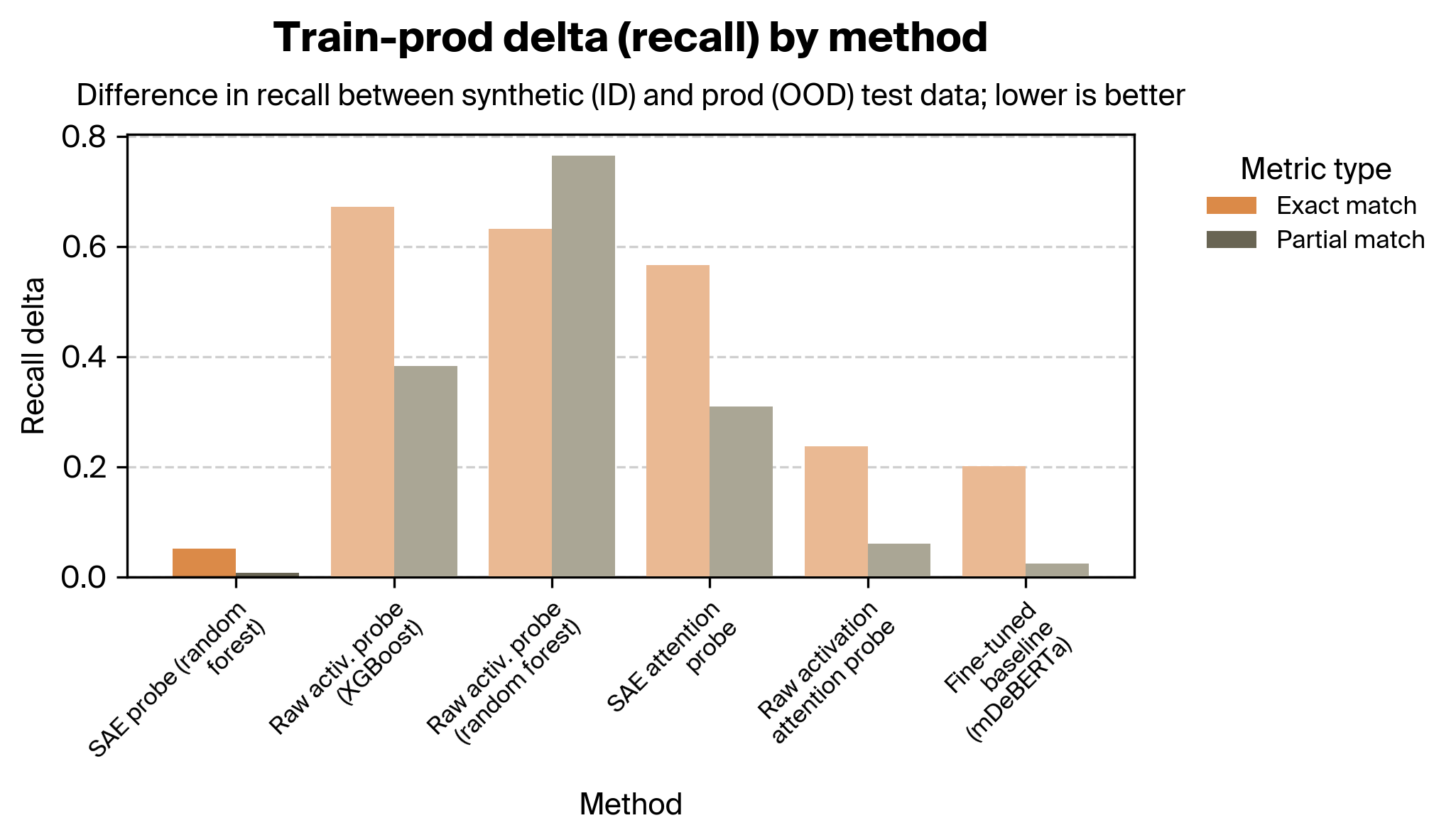
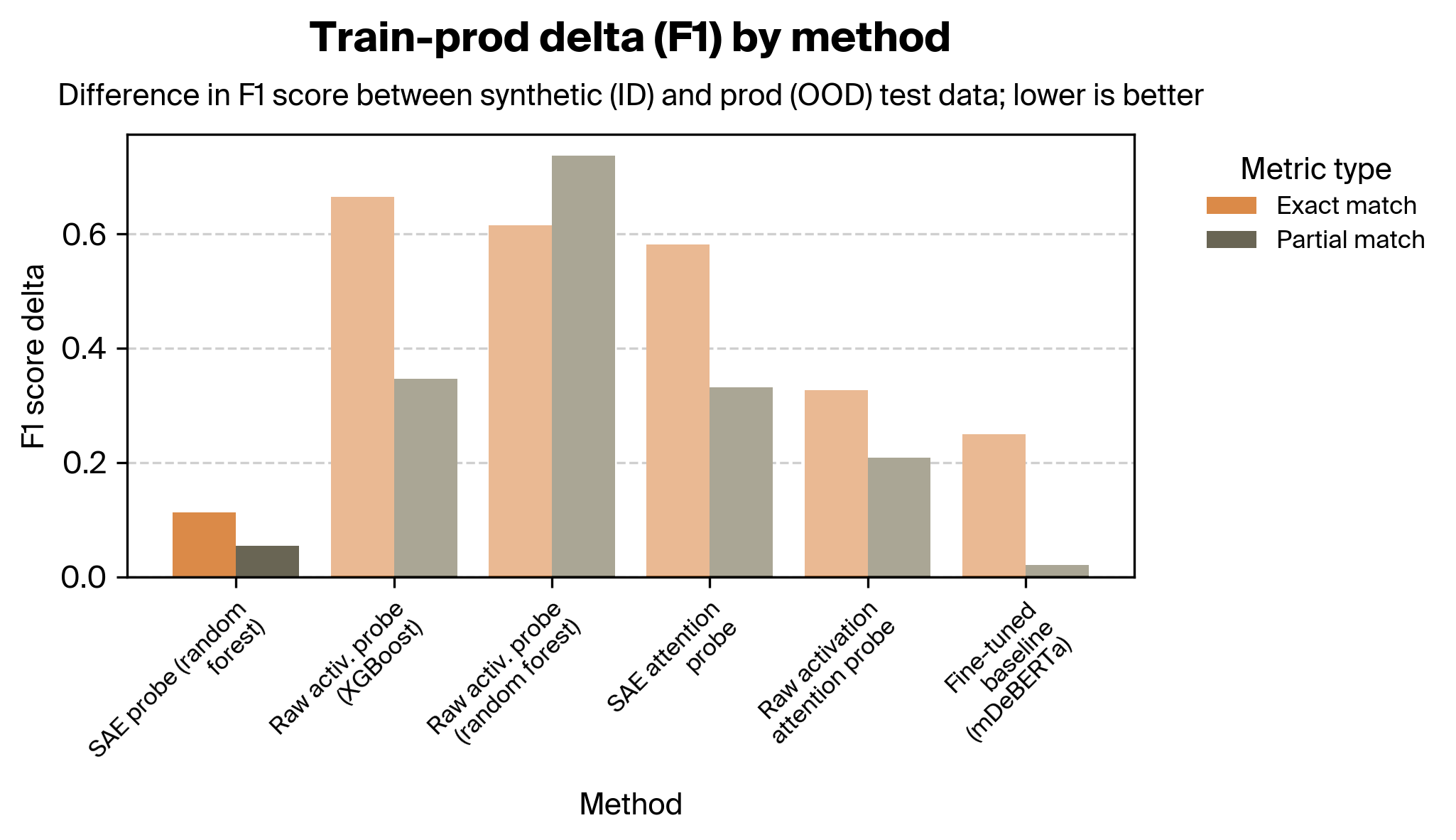
2. F1 score across synthetic-to-real shift
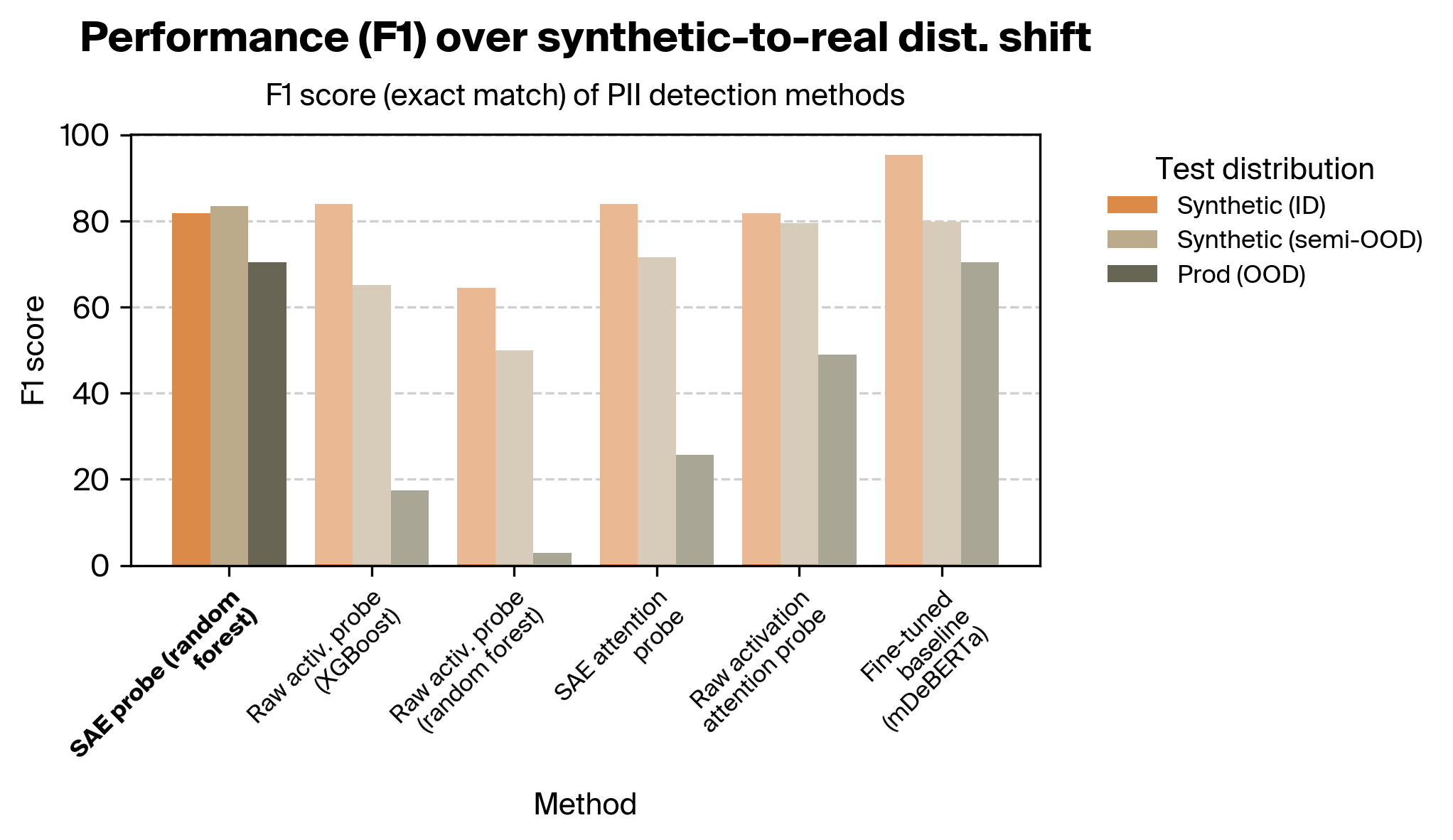
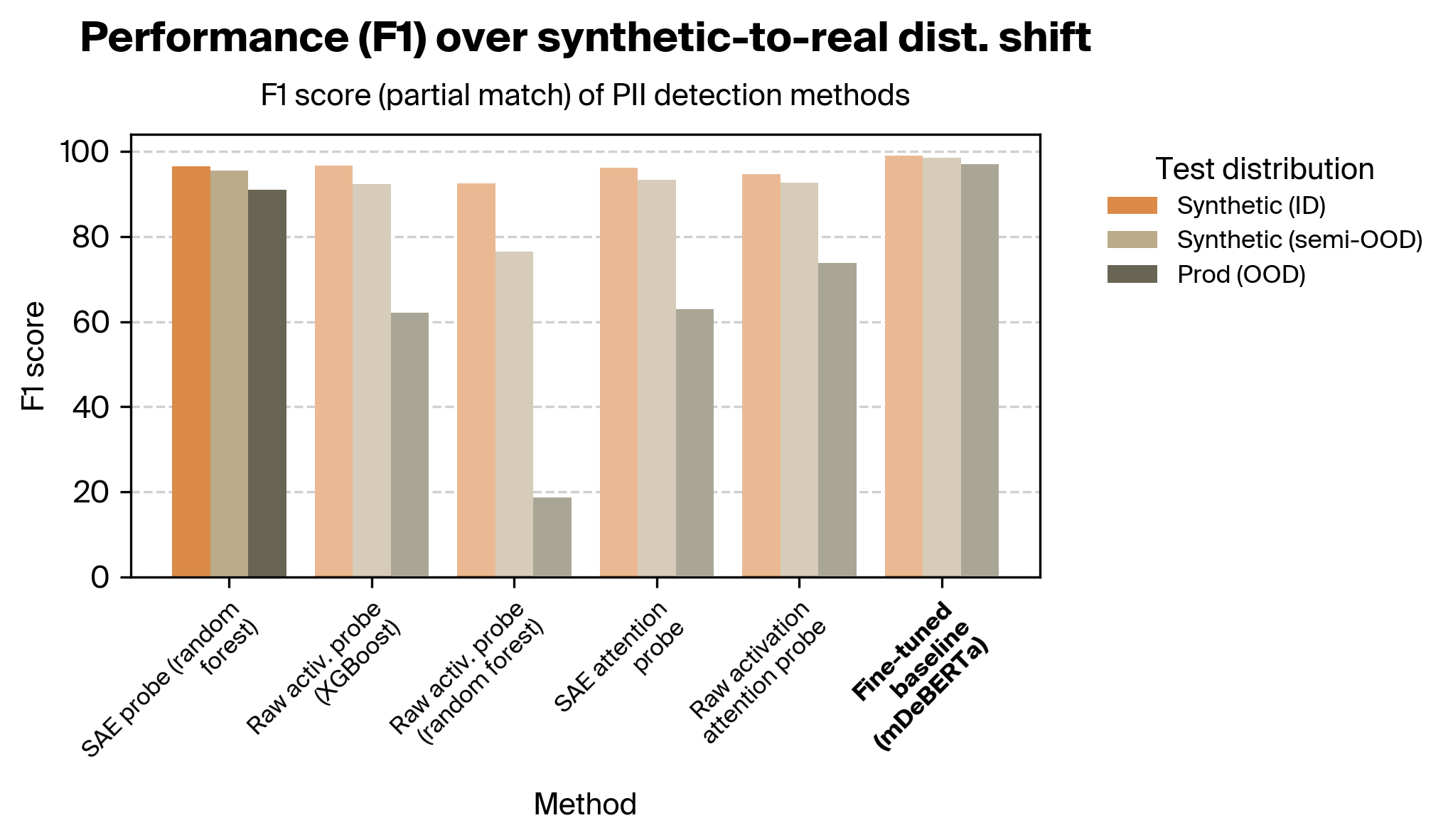
3. Performance by language setting
We also found that, on the training distribution, SAE probes outperform activation probes in Japanese-only and multilingual settings, but not on English-only data:
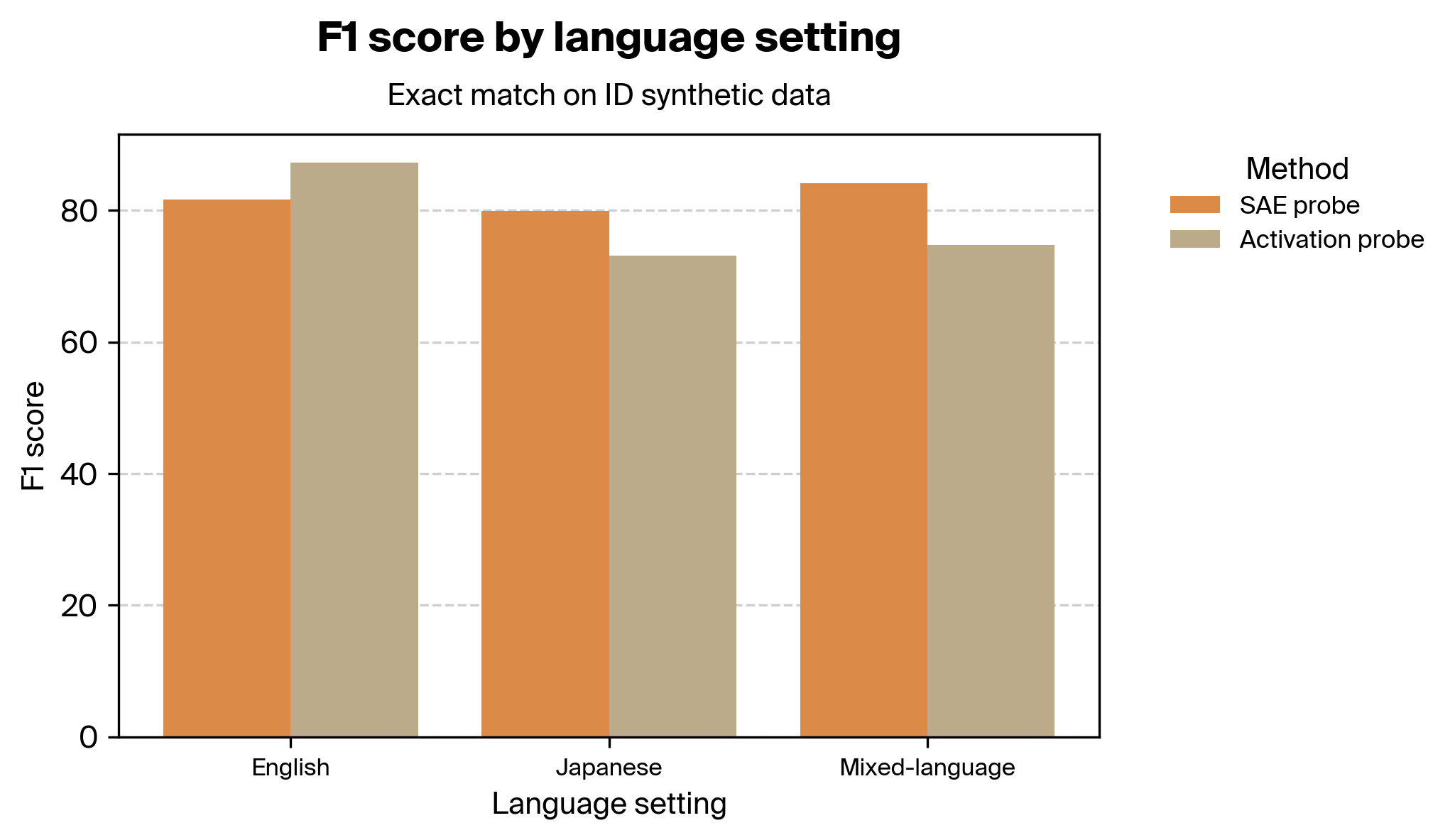
Note that these results use different SAEs; the Japanese results in particular are not one-to-one comparable with the others since they use a different base model (Llama 3.1 8B Instruct vs. Llama 3.1 8B base for the rest), a slightly different SAE architecture (BatchTopKTied vs. BatchTopK for the rest), and a larger expansion factor (32).
Since many of Rakuten's customers do not interact with their agent in English, performance in Japanese is crucial.
4. Label noise
We also examined the robustness of different probing methods to label noise.
In these experiments, we mislabeled some percentage (50%, 25%, 15%, 10%, 5%, 3%, 2%, or 1%) of the training dataset, incorrectly marking labels on random PII tokens to a different class of PII.
All results below use random forest classifiers, except for the Japanese activation probe, which uses XGBoost.
We found that SAE probes (orange) generally outperformed activation probes (blue) across label corruption percentages, including on English-only data.
